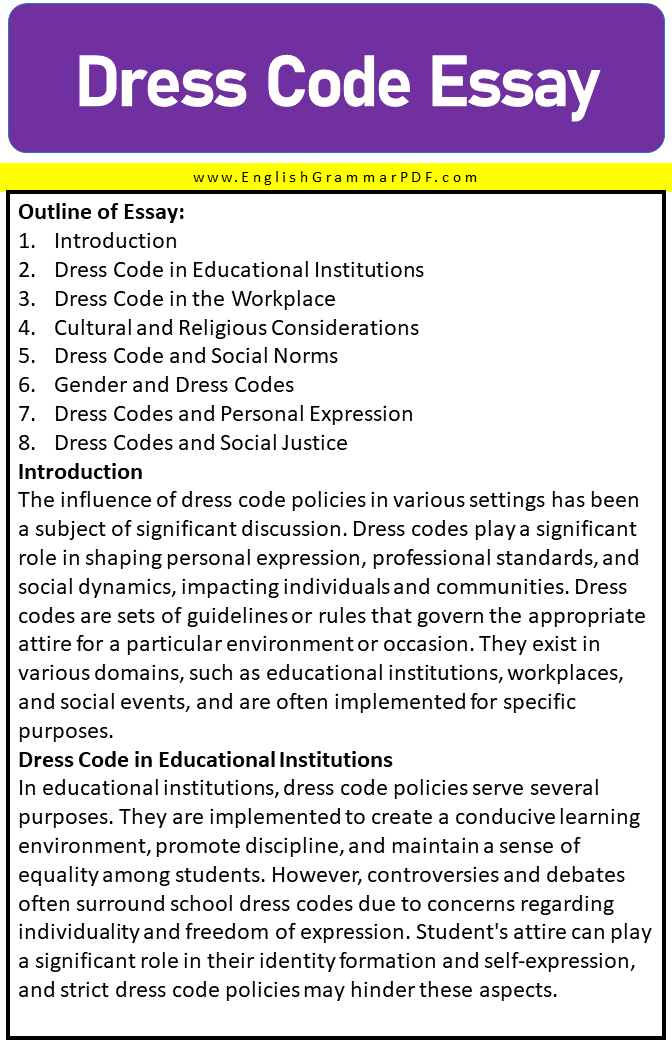Dress Code Essay
Outline of Essay:
- Introduction
- Dress Code in Educational Institutions
- Dress Code in the Workplace
- Cultural and Religious Considerations
- Dress Code and Social Norms
- Gender and Dress Codes
- Dress Codes and Personal Expression
- Dress Codes and Social Justice
Introduction
The influence of dress code policies in various settings has been a subject of significant discussion. Dress codes play a significant role in shaping personal expression, professional standards, and social dynamics, impacting individuals and communities. Dress codes are sets of guidelines or rules that govern the appropriate attire for a particular environment or occasion. They exist in various domains, such as educational institutions, workplaces, and social events, and are often implemented for specific purposes.
Dress Code in Educational Institutions
In educational institutions, dress code policies serve several purposes. They are implemented to create a conducive learning environment, promote discipline, and maintain a sense of equality among students. However, controversies and debates often surround school dress codes due to concerns regarding individuality and freedom of expression. Student’s attire can play a significant role in their identity formation and self-expression, and strict dress code policies may hinder these aspects.
Dress Code in the Workplace
The workplace is another domain where dress codes hold importance. Professional appearance and dress standards contribute to creating a positive corporate image and fostering a sense of professionalism. Dress code policies in the workplace aim to establish a level of uniformity and set expectations for employees’ attire.
However, finding a balance between individuality and professionalism can be a challenge. Some argue that rigid dress codes stifle creativity and self-expression, while others believe they enhance professionalism and create a sense of unity among employees.
Cultural and Religious Considerations
Dress codes often intersect with cultural and religious practices. Different cultures and religions have specific attire that holds deep meaning and significance. It is essential to respect diversity and accommodate different dress norms to create inclusive environments. This involves understanding the cultural and religious significance of attire and addressing potential conflicts that may arise due to dress code policies.
Dress Code and Social Norms
Dress codes reflect societal values and expectations. They influence the formation of social norms and can contribute to conformity or rebellion. In certain contexts, dress codes may lead to the creation of subcultures or groups that identify themselves through their distinctive attire.
Balancing personal style and societal norms in fashion choices is an ongoing challenge. Some argue that strict adherence to dress codes limits individuality, while others believe that following dress codes demonstrates respect for social norms and traditions.
Gender and Dress Codes
Gender plays a significant role in dress codes, often resulting in different expectations and double standards. Dress codes can impact individuals’ self-esteem and body image, particularly affecting women. Movements advocating for gender-neutral dress codes and freedom of expression challenge these gendered expectations and aim to create inclusive environments.
Dress Codes and Personal Expression
Clothing is a powerful means of communication, allowing individuals to express their individuality and personality. Within the boundaries of dress codes, there is room for creative expression. Exploring alternative ways of expressing identity beyond physical appearance can empower individuals to embrace their uniqueness and express themselves authentically.
Dress codes can contribute to body shaming and perpetuate unrealistic beauty standards. Promoting inclusivity and acceptance of diverse body types is crucial. Emphasizing self-acceptance and confidence regardless of dress codes can foster a positive body image and promote a healthy relationship with one’s appearance.
Dress Codes and Social Justice
Examining dress code biases and their impact on marginalized groups is important for promoting social justice. Equitable enforcement of dress codes is crucial to avoid discrimination. Dress code policies can be used as an opportunity for education, fostering empathy, and promoting a more inclusive and accepting society.
FAQ’s
What are the main types of dress codes?
The main types of dress codes include formal, business casual, casual, smart casual, and specific dress codes such as black tie, white tie, and uniform dress codes.
What is the most popular dress code?
The most popular dress code varies depending on the context and setting, but generally, business casual is a widely adopted dress code in many professional environments and social events.
Why is the dress code a problem?
Dress code can be a problem as it can infringe on personal expression, reinforce gender stereotypes, contribute to body shaming, and create a lack of inclusivity and diversity in social and professional settings.
Download the PDF of the Essay:
Explore More Essays:






